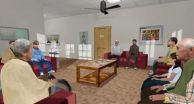(Press-News.org) VIDEO:
Dr. Gail Smith, a veterinary orthopedic surgeon, discusses the PennHIP method for diagnosing a dog's susceptibility to osteoarthritis.
Click here for more information.
PHILADELPHIA –- A study comparing a University of Pennsylvania method for evaluating a dog's susceptibility to hip dysplasia to the traditional American method has shown that 80 percent of dogs judged to be normal by the traditional method are actually at risk for developing osteoarthritis and hip dysplasia, according to the Penn method.
The results indicate that traditional scoring of radiographs that certify dogs for breeding underestimate their osteoarthritis susceptibility. The results are of clinical importance to several populations, most notably veterinarians, breeders and pet owners.
The two hip screening methods -- the standard Orthopedic Foundation for Animals, or OFA model, and Penn Vet's PennHIP model -- were applied to a sample of 439 dogs older than 2 years. The four most common breeds included in the study were German shepherds, Labrador retrievers, golden retrievers and Rottweilers, all breeds commonly susceptible to hip dysplasia.
According to Penn researchers, even if breeders were to selectively breed only those dogs having OFA-rated "excellent" hips -- the highest ranking but in some breeds, a very small gene pool, the study suggests that 52-100 percent of the progeny, depending on breed, would be susceptible to hip dysplasia based on the Penn Vet scoring method.
"We believe the lower rates of hip laxity detection using the OFA methods are not the fault of the expert radiologist reading the radiograph but rather a deficiency of the radiographic view," said veterinary surgeon Gail Smith, professor of orthopaedic surgery, lead author and director of the PennHIP Program. "We believe many veterinarians are not using the best test to control a disease. In many ways this is an animal-welfare issue."
The findings point to a weakness in current breeding practices. If breeders continue to select breeding candidates based upon traditional scores, then, according to the Penn study, breeders will continue to pair susceptible dogs and fail to improve hip quality in future generations. Despite well intentioned hip-screening programs to reduce the frequency of the disease, canine hip dysplasia continues to have a high prevalence worldwide with no studies showing a significant reduction in disease frequency using mass selection.
Canine hip dysplasia, or CHD, is defined by the radiographic presence of hip joint laxity or osteoarthritis with hip subluxation (laxity) early in life. A developmental disease of complex inheritance, it is one of the most common orthopaedic diseases in large and giant-breed dogs and causes pain and loss of mobility.
The traditional OFA screening method relies heavily on conventional hip-extended, or HE, radiographs, which the study contends do not provide critical information needed to accurately assess passive hip joint laxity and therefore osteoarthritis susceptibility.
"We suspect that all hip-screening systems worldwide based on the HE radiograph have similar diagnostic deficiencies," Smith said. "Hopefully, our results will motivate veterinarians and breeders to consider this newer approach."
To achieve genetic control of CHD, researchers said, an accurate test must minimize false-negative diagnoses which mistakenly permit the breeding of dogs that carry genes coding for CHD. Particularly for a late-onset disease such as CHD, dogs remaining in the gene pool must not only be free of obvious signs of CHD at the time of evaluation (2 years of age for OFA) but ideally should not be susceptible to the osteoarthritis of CHD that occurs later in life.
The PennHIP method quantifies hip laxity using the distraction index, or DI, metric which ranges from a low of .08 to greater than 1.5. Smaller numbers mean better hips. The PennHIP DI has been shown in several studies at multiple institutions to be closely associated with the risk of osteoarthritis and canine hip dysplasia. It can be measured as early as 16 weeks of age without harm to the puppy.
Specifically, the PennHIP method considers a DI of less than .3 to be the threshold below which there is a near zero risk to develop hip osteoarthritis later in life. In contrast, dogs having hip laxity with DI higher than .3 show increasing risk to develop hip osteoarthritis, earlier and more severely, as the DI increases.
Comparing the overall results of the study, 52 percent of OFA-rated "excellent," 82 percent of OFA-rated "good" and 94 percent of OFA-rated "fair" hips all fell above the PennHIP threshold of .3, making them all susceptible to the osteoarthritis of CHD though scored as "normal" by the OFA. Of the dogs the OFA scored as "dysplastic," all had hip laxity above the PennHIP threshold of .3, meaning there was agreement between the two methods on dogs showing CHD or the susceptibility to CHD.
The key feature of the PennHIP radiographic method is its ability to determine which dogs may be susceptible to osteoarthritis later in life. Because dogs are recognized as excellent models for hip osteoarthritis in humans, the authors are interested in the prospect of applying this technology to humans. Knowing a dog's risk for osteoarthritis early would allow veterinarians to prescribe proven preventive strategies, like weight loss, to lower the risk of this genetic disorder. Also, dog breeders now have a more informative measure to determine breeding quality to lower the risk of hip osteoarthritis in future generations of dogs.
"In humans, with appropriate studies of course, it is conceivable that mothers of susceptible children — and there are many — may adjust a child's lifestyle, including diet, to delay the onset or lessen the severity of this genetic condition," Smith said.
PennHIP is currently in common use by service-dog organizations such as the U.S. Air Force, the U.S. Army and numerous dog-guide schools. There are approximately 2,000 trained and certified members currently performing PennHIP procedure worldwide.
INFORMATION:
The study was conducted by Smith, Michelle Y. Powers, Georga T. Karbe, Thomas P. Gregor, Pamela McKelvie, William T. N. Culp and Hilary H. Fordyce of the Department of Clinical Studies at Penn Vet. Culp is currently with the School of Veterinary Medicine at the University of California, Davis.
The study was funded by the University of Pennsylvania, the National Institutes of Health, The Seeing Eye Inc., the Morris Animal Foundation and Nestle Purina Co.
Smith, who is the inventor, and the University of Pennsylvania, which holds the patent, have a financial interest in the PennHIP method."
A video in which Dr. Gail Smith describes this study is available at http://www.youtube.com/watch?v=VG_fJvevbJ8.
Hip dysplasia susceptibility in dogs may be underreported, according to Penn Vet comparative study
2010-09-04
ELSE PRESS RELEASES FROM THIS DATE:
Human unconscious is transferred to virtual characters
2010-09-04
Virtual characters can behave according to actions carried out unconsciously by humans. Researchers at the University of Barcelona have created a system which measures human physiological parameters, such as respiration or heart rate, and introduces them into computer designed characters in real time.
"The ultimate aim is to develop a method which allows humans to unconsciously relate with some parts of the virtual environment more intensely than with others, and that they are encouraged only by their own physiological responses to the virtual reality shown", Christoph ...
Cluster turns the invisible into the visible
2010-09-04
Cluster has spent a decade revealing previously hidden interactions between the Sun and Earth. Its studies have uncovered secrets of aurora, solar storms, and given us insight into fundamental processes that occur across the Universe. And there is more work to do.
The aurora, those dancing lights in the polar skies, are but the visible manifestation of an invisible battle taking place above our heads. Supersonic particles from the Sun collide with our planet's magnetic field every day. Most are deflected away but some are trapped by Earth's magnetism and accelerated to ...
Miniature auto differential helps tiny aerial robots stay aloft
2010-09-04
CAMBRIDGE, Mass., Sept. 2, 2010 -- Engineers at Harvard University have created a millionth-scale automobile differential to govern the flight of minuscule aerial robots that could someday be used to probe environmental hazards, forest fires, and other places too perilous for people.
Their new approach is the first to passively balance the aerodynamic forces encountered by these miniature flying devices, letting their wings flap asymmetrically in response to gusts of wind, wing damage, and other real-world impediments.
"The drivetrain for an aerial microrobot shares ...
Dynamic memory mapping delivers additional flexibility to virtual resource management
2010-09-04
The Department of Computer Science and Technology, Peking University, Beijing, China, has shown that a novel dynamic memory mapping (DMM) model brings about additional flexibility to virtual resource management, leading to the feature-adjustable design of a virtual machine monitor (VMM). The study is reported in Issue 53 (June, 2010) of SCIENCE CHINA Information Sciences because of its significant research value.
Memory is one of the most frequently accessed components in virtual machine (VM) systems. Because a VM's memory requirement varies according to the running applications, ...
Effect of heat treatment on the superconducting properties of Ag-doped Sr0.6K0.4Fe2As2 compounds
2010-09-04
The Key Laboratory of Applied Superconductivity, Institute of Electrical Engineering, Chinese Academy of Sciences, Beijing, and China Research have collaborated to reveal the heat treatment effects on the superconducting properties of Ag-doped Sr0.6K0.4Fe2As2 compounds. Because of its significant research value, the study is reported in issue 7 of SCIENCE CHINA Physics, Mechanics & Astronomy.
Previously, our group studied the effect of adding Ag to polycrystalline Sr0.6K0.4Fe2As2 and found that the critical current density Jc and the irreversibility field increase markedly. ...
Image-based modeling of inhomogeneous single-scattering participating media
2010-09-04
The State Key Laboratory of Virtual Reality Technology and Systems, Beihang University in Beijing, has proposed an image based modeling method for inhomogeneous single-scattering participating media whose density fields may contain high frequency details [1]. This work could reduce the difficulty in capturing real-world participating media, which can be applied to 3D games, film production, virtual reality systems, etc. This study is reported in Volume 53 (June, 2010) of the Science China Information Sciences journal because of its significant research value.
Realistic ...
Medicinal cannabis review highlights dilemmas facing health care professionals
2010-09-04
Nurses have a responsibility to respect and support patients who use cannabis for medicinal purposes, but must stay within the law and follow professional guidance at all times, according to a research review in the September issue of the Journal of Clinical Nursing.
Dr Anita Green and Dr Kay De-Vries studied more than 50 published papers, together with professional and Government guidance documents, official reports and media coverage, from 1996 to 2009.
They point out that the fact that the cannabis is usually obtained illegally can have consequences for those who ...
Recipe for water: Just add starlight
2010-09-04
ESA's Herschel infrared space observatory has discovered that ultraviolet starlight is the key ingredient for making water in space. It is the only explanation for why a dying star is surrounded by a gigantic cloud of hot water vapour.
Every recipe needs a secret ingredient. When astronomers discovered an unexpected cloud of water vapour around the old star IRC+10216 in 2001, they immediately began searching for the source. Stars like IRC+10216 are known as carbon stars and are thought not to make much water. Initially they suspected the star's heat must be evaporating ...
Long term use of oral bisphosphonates may double risk of esophageal cancer
2010-09-04
People who take oral bisphosphonates for bone disease over five years may be doubling their risk of developing oesophageal cancer (cancer of the gullet), according to a new study published on bmj.com today.
Oral bisphosphonates are a type of drug used to treat osteoporosis and other bone diseases and are the most commonly recommended treatment for such conditions.
Case reports suggest an association between use of oral bisphosphonates for osteoporosis and increased risk of oesophageal cancer. But the evidence is limited, and no adequately large study with information ...
Roll-out of electronic patient records likely to be a long and complex process
2010-09-04
Interim results from the first comprehensive evaluation of the implementation of electronic health records in secondary care in England have found delays and frustration with the system, according to research published on bmj.com today.
The authors, led by Professor Aziz Sheikh from The University of Edinburgh (and which included researchers from The London School of Economics and Political Science, The School of Pharmacy and The University of Nottingham), say experiences from the first-wave implementation site "indicate that delivering improved healthcare through nationwide ...



